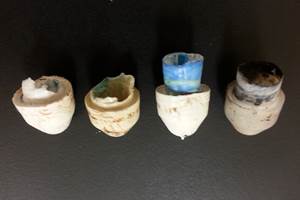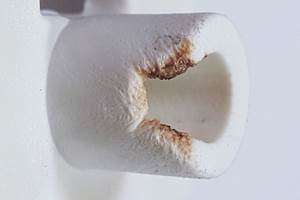For Better Process Control Start With Simulation
A new generation of process-control systems interpret results of injection molding simulation as the starting point for machine settings and control setpoints.
Efforts to make injection machine set-up and control less of an art and more of a science have taken a step forward with the emergence of new systems that marry molding simulation with process control. Using personal computers and commonplace sensors in conjunction with proprietary software and hardware, these systems hold out the prospect of automatic set-up, optimization, and control of the molding process. Three such systems have appeared in recent months.
Moldflow Corp. in September introduced the Moldflow Plastics Xpert (MPX) system (see PT, Sept. '98, p. 49). Working alongside the machine controller, MPX has three software modules that together determine machine set-ups, optimize molding conditions, and make process corrections. All the modules employ a rule-based expert system, says Roland Thomas, Moldflow's v.p. of R&D.
A competing system comes from Plastics & Computer Inc., which introduced its Knowledge-Aided Molding Machine Setting (KAMMS) expert-system software at the recent K'98 show in Dusseldorf. According to Giorgio Bertacchi, one of the company's founders, KAMMS employs simulation results, materials data, and a machinery database to aid both machinery selection and set-up. KAMMS also has a link to Sandretto machine controllers to provide process-control recommendations.
The latest development comes from Cornell University's Injection Molding Program (CIMP), which has devised its own system for optimization and process control. Called the Integrated Molding System (IMS), it was developed with technical aid and funding from C-Mold, Moog Japan Ltd., United Technologies Automotive, GINTIC (Singapore's Institute of Manufacturing Technology), and the National Science Foundation. Beyond its use of simulation results, IMS relies on a patent-pending adaptive-control method based on measuring mold separation throughout the molding cycle. Still in development, the system will ultimately be marketed by Moog, according to Yasuaki Sakurai, senior engineer at Moog Japan.
Starting with simulation
These four new systems differ substantially in how they handle process control, but they share one defining feature: All have the ability to use molding simulation software to determine the machine set-up conditions. Users enter information on part design and quality requirements, and the software interprets simulation results to come up with suggested machine set-up conditions. These include cooling times and profiles for temperatures, ram velocities, and injection and holding pressures.
The simulation software used by each system depends, of course, on the vendor. For Moldflow, it is the company's Dynamic Series or Part Adviser. For Plastics & Computer, it's TMConcept. CIMP's system uses Dr. C-Mold, a simplified, one dimensional simulation package that does not require users to know the actual part geometry.
While simulation is an important component of these systems, it is not mandatory. Moldflow v.p. Ken Welch explains that MPX ideally uses simulation for the maximum benefit, but it can also accept a direct upload of existing set-up parameters or manual inputs from a "set-up wizard" that walks users through the data-entry routine.
Likewise, the KAMMS system, which is built on the company's earlier CAMMS computer-aided machinery selection software, will work without simulation inputs. However, it is better to run a simulation, Bertacchi advises.
CIMP's IMS, by contrast, does need Dr. C-Mold to generate the initial set-up parameters. K.K. Wang, director of CIMP, argues that simulation brings major benefits to these new control systems: concurrent part design, tool design, and process engineering. "The point is providing a technology to optimize all three simultaneously," he says.
Sizing the process window
More than just suggesting the initial set-up points, these systems also have the ability to establish a processing window through design-of-experiments (DOE) trials.
In Moldflow's case, an optimization module called Moldspace Xpert establishes a molding window by running a simplified DOE routine. The software guides users through the DOE, which typically takes only eight shots to complete. Users inspect the parts from each shot and then enter defect information from a drop-down menu.
KAMMS also has an automatic DOE feature. Users define what quality means for a given application by entering plain-language descriptions such as "desirable" or "essential" for appearance, dimensions, and other quality attributes. Once the system sends these data along with a target Cpk to the machine, the software can walk users through a two-level, three-parameter DOE.
At present, the Cornell IMS lacks explicit automation tools for performing DOEs on the molding machine. Wang notes, however, that IMS will soon provide off-line tools for DOE and optimization. These tools will be based on full-fledged simulation software, which will generate the set-up parameters and the on-line control model.
Many routes to process control
Leaving aside arguments about the relative merits of different simulation software, what really differentiates these systems is how they handle process control--and specifically how they interact with the molding machine controller.
MPX's forerunner, Moldflow's Intelligent Process Control (IPC) system, would have taken over the many of the functions of the machine controller by directly adjusting process parameters during the molding cycle. That approach raised potential safety and liability concerns for molders and machinery makers. MPX, by contrast, monitors screw cushion and mold packing and then makes any changes in the following cycle by uploading a new set of process parameters to the machine controller, Welch explains.
CIMP's IMS system represents a different strategy, in which an add-on Moog digital controller takes over regulation of ram speed and packing pressure from the machine controls. While the Moog controller directly controls these two parameters, all other functions remain under control of the machine controller--though Sakurai notes that the commercial system will employ a controller capable of taking over all machine functions.
CIMP's method of controlling part quality within user-specified limits rests on the measurement of mold separation by a standard LVDT sensor on the mold. As the filling of the cavity forces the mold to separate, IMS first decelerates the ram to prepare for switchover. Then when the separation reaches a certain value--which IMS calculates automatically on a shot-to-shot basis from a control model--IMS actuates the boost-to-hold switchover.
After switchover, a mold-separation profile is used to control the packing pressure. "Mold separation is highly correlated to cavity pressure," says Dr. Jian Zhou, a Cornell researcher and one of IMS's inventors. He adds that it's easier to put mold-separation sensors outside the tool than to install a pressure sensor inside the cavity.
IMS's adaptive quality-control loop primarily serves to achieve a uniform part weight, since there's a linear relationship between mold separation and weight, claims Zhou (see table). "What we do is directly control part quality," he says.
KAMMS, which can be linked directly to Sandretto machine controllers, leaves the monitoring and control actions to the machine controller once the software has determined optimum settings. KAMMS also offers a problem-analysis tool that graphically indicates the likelihood that a particular process adjustment will solve a molding problem. If the user chooses, the solutions suggested by this tool can be uploaded to the controller as new setpoints.
Related Content
How to Start a Hot-Runner Mold That Has No Tip Insulators
Here's a method to assist with efficient dark-to-light color changes on hot-runner systems that are hot-tipped.
Read MoreImprove The Cooling Performance Of Your Molds
Need to figure out your mold-cooling energy requirements for the various polymers you run? What about sizing cooling circuits so they provide adequate cooling capacity? Learn the tricks of the trade here.
Read MoreBack to Basics on Mold Venting (Part 1)
Here’s what you need to know to improve the quality of your parts and to protect your molds.
Read MoreBest Methods of Molding Undercuts
Producing plastics parts with undercuts presents distinct challenges for molders.
Read MoreRead Next
Advanced Recycling: Beyond Pyrolysis
Consumer-product brand owners increasingly see advanced chemical recycling as a necessary complement to mechanical recycling if they are to meet ambitious goals for a circular economy in the next decade. Dozens of technology providers are developing new technologies to overcome the limitations of existing pyrolysis methods and to commercialize various alternative approaches to chemical recycling of plastics.
Read MoreHow Polymer Melts in Single-Screw Extruders
Understanding how polymer melts in a single-screw extruder could help you optimize your screw design to eliminate defect-causing solid polymer fragments.
Read MoreProcessor Turns to AI to Help Keep Machines Humming
At captive processor McConkey, a new generation of artificial intelligence models, highlighted by ChatGPT, is helping it wade through the shortage of skilled labor and keep its production lines churning out good parts.
Read More





























